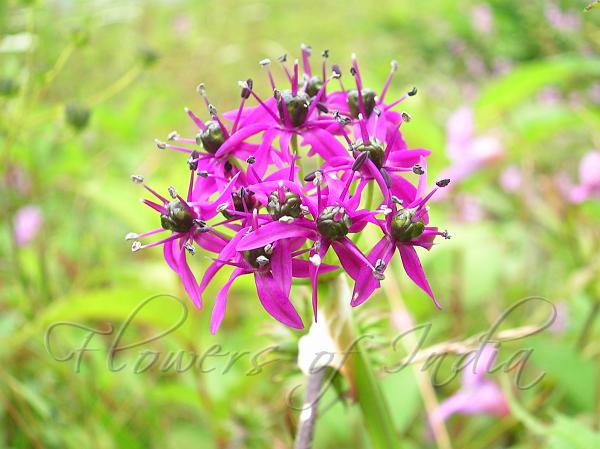|
| Himalayan Onion |
|

|

| File size | 573505 |
| Original date | 8/15/06 12:54 PM |
| Resolution | 2048 x 1536 |
| Flash | Flash did not fire, auto |
| Focal length | 8.0mm |
| Exposure time | 1/116s |
| Aperture | 3.2 |
| Focus Distance | |
| Metering Mode | Partial |
| Camera make | NIKON |
| Camera model | E3700 |
| Sensor type |
|
|
|
|
Photo: |
Botanical name: Allium wallichii Family: Amaryllidaceae (Nargis family)
Synonyms: Allium polyastrum, Allium bulleyanum, Allium praelatitium
Synonyms: Allium polyastrum, Allium bulleyanum, Allium praelatitium
Himalayan Onion is a perennial herb with numerous
purple flower, borne in a lax rounded umbel 5-7 cm
across, on top of a leafless 3-angled flowering-stem, 1-3 ft. Petals
are broadly linear blunt, spreading in a star, at length reflexed,
longer than the purple stamens and ovary. Leaves are many,
spear-shaped, flat and keeled, up to 2 cm broad, often almost as long
as the flowering stem. Bulb is solitary or clustered, cylindric; tunic
yellowish brown, fibrous. Himalayan Onion is found in the Himalayas,
from Pakistan to SW China, at altitudes of 2800-4300 m.
Medicinal uses: The bulbs, boiled then fried
in ghee, are eaten in the treatment of cholera and dysentery. The raw
bulb is chewed to treat coughs and colds. It is said that eating the
bulbs can ease the symptoms of altitude sickness. Members of this genus
are in general very healthy additions to the diet. They contain sulphur
compounds (which give them their onion flavour) and when added to the
diet on a regular basis they help reduce blood cholesterol levels, act
as a tonic to the digestive system and also tonify the circulatory
system.
The bulbs, boiled then fried
in ghee, are eaten in the treatment of cholera and dysentery. The raw
bulb is chewed to treat coughs and colds. It is said that eating the
bulbs can ease the symptoms of altitude sickness. Members of this genus
are in general very healthy additions to the diet. They contain sulphur
compounds (which give them their onion flavour) and when added to the
diet on a regular basis they help reduce blood cholesterol levels, act
as a tonic to the digestive system and also tonify the circulatory
system.
Medicinal uses:
 The bulbs, boiled then fried
in ghee, are eaten in the treatment of cholera and dysentery. The raw
bulb is chewed to treat coughs and colds. It is said that eating the
bulbs can ease the symptoms of altitude sickness. Members of this genus
are in general very healthy additions to the diet. They contain sulphur
compounds (which give them their onion flavour) and when added to the
diet on a regular basis they help reduce blood cholesterol levels, act
as a tonic to the digestive system and also tonify the circulatory
system.
The bulbs, boiled then fried
in ghee, are eaten in the treatment of cholera and dysentery. The raw
bulb is chewed to treat coughs and colds. It is said that eating the
bulbs can ease the symptoms of altitude sickness. Members of this genus
are in general very healthy additions to the diet. They contain sulphur
compounds (which give them their onion flavour) and when added to the
diet on a regular basis they help reduce blood cholesterol levels, act
as a tonic to the digestive system and also tonify the circulatory
system. | Identification credit: Tabish | Photographed in Valley of Flowers & Gangi, Uttarakhand. |
• Is this flower misidentified? If yes,